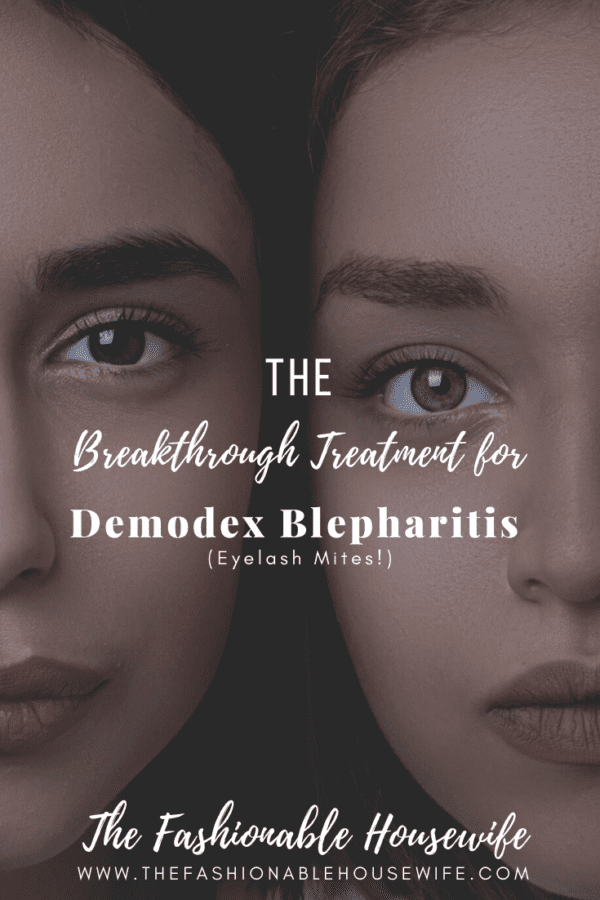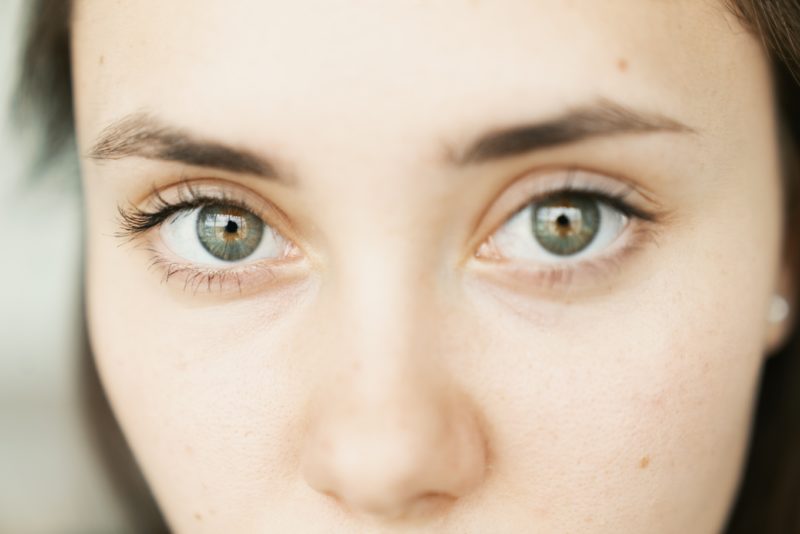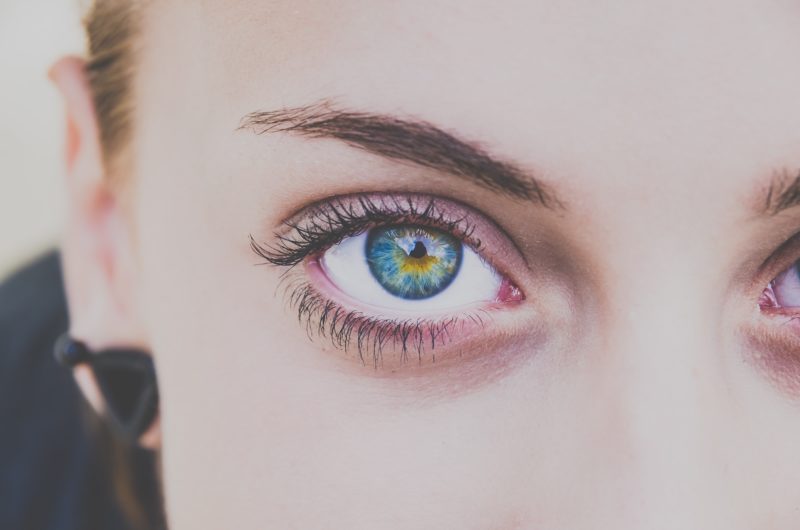
This will not be welcome news to most people, but it’s the truth: you almost definitely have microscopic mites living in the pores of your skin at this very moment. They’re called Demodex mites, also known as eyelash mites, and nearly every adult human hosts a colony of them on their skin. At only .3 millimeters long you can’t see them with the naked eye, but these mites look like stubby worms. To creep you out just a tiny bit more, they’re actually arachnids, related to ticks and spiders. Generally speaking, these tiny stowaways are not harmful. However, in some cases, an overabundance of mites can lead patients to seek out Demodex eyelid treatment to address an uncomfortable eye condition called blepharitis.
If your mother ever told you NOT to share makeup like mascara and eyeliner with your girlfriends when you were younger, THIS IS WHY! Turns out it’s not an old wives tale, mom was trying to protect your eyes from eyelash mites!
What Is Blepharitis?
Blepharitis is a common, yet generally overlooked, eye disease causing eyelid inflammation, redness, swelling, soreness, irritation, itching, or burning, with the development of dandruff-like scales on the lashes. There are several different types of blepharitis, including the following:
- Bacteria (staphylococcal blephoritis) or dandruff of the eyebrows and scalp (seborrheic blepharitis) can cause an infection if they become too plentiful or cause a poor reaction on the lid area.
- If the eyelid glands produce an irregular amount of oil, posterior blepharitis can occur (meibomian blepharitis), with a favorable setting for bacteria to grow. Rosacea can also cause posterior blepharitis
- Demodex blepharitis is the type caused by those pesky mites living in your pores. They leave the protection of your pores while you sleep to eat dead skin cells, mate, and expel waste. In small numbers, the mites can actually provide beneficial exfoliation for the skin, but in large numbers they can cause extensive damage, requiring Demodex eyelid treatment as the oil glands at the base of the eyelashes become blocked.
What Are Demodex Mites?

The Demodex mite is an ectoparasitic arachnid that lives on the host’s surface, residing in sebaceous glands and hair follicles. There are actually 65 documented species of Demodex, but only two are found on humans: Demodex brevis and Demodex folliculorum. The Demodex brevis mite lives inside the meibomian glands and the lash’s sebaceous glands and is believed to be associated with meibomian gland disease and tear lipid deficiency. Demodex folliculorum is the mite associated with anterior blepharitis, as it burrows face down at the eyelash root. Longer than the brevis mite and boasting a tapered body, the folliculorum typically lives in clusters whereas the brevis is more solitary. The folliculorum mite increases the number of skin cells in hair follicles, which can create scaly patches on the skin when present in large amounts. The mites occur naturally on human skin, but can also be spread through physical contact with others.
The Demodex mite usually only lives 2-3 weeks. The females lay 15-20 eggs in the hair follicle located around the sebaceous glands. These eggs grow into larvae and, eventually, an eight-legged adult mite. Adult male Demodex mites leave the hair follicles to look for a mate. They are more active in the dark, when they can walk 10 mm per hour. The mites eat dead skin cells, which can actually provide an exfoliation benefit to the host, if the mites only exist in small numbers. It’s when the Demodex mites reproduce in larger quantities and when they settle on the eyelids and lashes that blepharitis can occur and become a health issue, causing damage to the eyelids, skin, eyes and prompting victims to seek Demodex eyelid treatment.
Signs of Demodex and Blepharitis Mites
Researchers believe there may be as many as 25 million cases of Demodex blepharitis in the United States. Common signs of the condition include the following:
- Abnormal growth of eyelashes
- Brittle eyelashes or lash loss
- Burning or stinging
- Collarettes, or cylindrical dandruff, at the eyelash base
- Dry eyes
- Eye irritation
- Foreign body sensation
- Gritty feeling in the eyes
- Infections of the eye or lid
- Intermittent blurred vision
- Itchy eyes or eyelids
- Light sensitivity
- Redness of the eye
- Tearing eyes
- White flakes in eyelashes
Who is Affected by Eyelash Mites?

Approximately 20 million Americans are affected by blepharitis, with 45% of those attributed to an infestation of Demodex mites. While this is obviously not an uncommon condition, you may benefit from Demodex eyelid treatment due to an increased risk of blepharitis and Demodex mites if you have the following conditions:
- acne, particularly inflammatory acne
- alopecia
- dermatitis
- HIV
- rosacea, which can be caused by Demodex mites or worsened by them
- skin infections
- weakened immune system
- age: it appears that the likelihood of having an infestation of Demodex increases with age. Demodex has been observed in 84% of 60-year-olds and 100% of adults over 70.
Negative Life Impacts
People diagnosed with Demodex blepharitis frequently report psychosocial effects occurring along with the condition, including low self-esteem and impairment that affects their work. A study of 311 patients with signs of Demodex blepharitis including presence of mites, collarettes on the lashes, and lid erythema were clinically examined and questioned about their quality of life. Here are the results:
- 47% of study respondents reported being conscious of their eyes throughout the day.
- 47% of those studied reported difficult night driving as a result of their blepharitis.
- 23% reported being in a constant state of worry about their eyes.
- 23% of those studied said the condition gave a negative appearance to their eyes or eyelids.
- 30% reported additional time required in their daily routine because of Demodex eyelid treatment due to their blepharitis.
- 34% of women said the blepharitis made it difficult to wear makeup, and 5% said that wearing artificial lashes was uncomfortable.
- 8% reduced wearing contact lenses
- 5% avoiding having eye surgery.
- 80% of respondents said the condition had affected their daily life in a negative way.
- Women (84%) statistically reported a greater level of negative impact than men (72%).
- 6% of respondents said the condition negatively impacted their mental state.
Commonly Recommended Demodex Blepharitis Treatment Options
The existence of Demodex mites can have profound effects on people afflicted with Demodex blepharitis. Obviously, controlling these mites is a high priority for those individuals. Here are some Demodex eyelid treatments that are commonly recommended and an explanation of the effectiveness or safety concerns of each:
- Baby shampoo
- This is an effective skin cleanser, but includes detergent and harmful ingredients such as cocamidopropyl betaine (CAPB), which was named “Allergen of the Year” in 2004. Although they are known for being mild, baby shampoos were not made for direct eye application.
- Eyelid cleansers
- These are a great first step for cleaning the eyelid, but may not penetrate deep enough to remove the mites or relieve symptoms.
- Eye drops
- Eye drops, particularly the lubricating type, are helpful for temporary soothing of painful symptoms, but extended use can exacerbate the condition.
- Warm compresses
- Warm compresses are a commonly prescribed Demodex eyelid treatment, helping to stabilize tear film, unclog glands from eyelash adhesives, and temporarily offer inflammation relief. However, conventional compresses can be messy and fail to hold heat for a long enough period of time, so patients tend to discontinue this practice before it reaches a level of effectiveness.
Tea Tree Oil for Demodex Blepharitis

Tea tree oil is an essential oil naturally distilled from the Australian Melaleuca alternifolia plant that has long been used in the treatment of wounds and skin infections. Tea tree oil added to a lid scrub is also a renowned Demodex eyelid treatment, used in eliminating the waxy cylindrical dandruff at the base of the eyelash. However, tea tree oil can cause irritation to the eye and allergic reactions on the skin. A published study by researchers Sean Tighe, Ying-Ying Gao, and Scheffer C.G. Tseng focused on identifying the active ingredient in tea tree oil that is most responsible for the reputed mite-killing effects. After isolating 15 ingredients used in commercial solutions of tea tree oil, the study identified Terpinen-4-ol as the ingredient with the strongest mite-killing properties.
What Is Terpinen-4-ol (T4O)?
- The study confirmed that Terpinen-4-ol (T4O) is the most effective active ingredient in tea tree oil.
- Chemically speaking, T4O is an isomer of terpineol.
- As a primary constituent of tea tree oil, T4O is believed to have great potential for clinical use.
What Are the Benefits of Terpinen-4-ol?
- T4O has been shown effective in eliminating mites when applied as a Demodex eyelid treatment for a period of eight weeks.
- T4O is also the ingredient in tea tree oil with the most antibacterial and antifungal properties.
- T4O has strong properties for antisepsis, disinfection, and sterilization, so it can be utilized as a natural disinfectant for treating illnesses and injuries.
- Antimicrobial effects of T4O have been observed in treating hospital-acquired infections and eye surface infections.
- T4O includes anti-inflammatory properties, which can help with eye treatment by reducing production of superoxides and pro-inflammatory cytokines. This reduces eye irritation and results in improved vision.
Get Treatment For Eyelash Mites Now!

If you are experiencing symptoms of Demodex blepharitis, your best option is to clear the mites using a natural Demodex eyelid treatment and lash cleanser that includes the mite-killing, anti-inflammatory properties of T4O without the irritants of regular tea tree oil. Check out the patented formula of Cliradex, available in both towelette or foam cleanser.
https://iovs.arvojournals.org/article.aspx?articleid=2774001
https://pubmed.ncbi.nlm.nih.gov/24349880/
https://www.healthline.com/health/demodex-folliculorum
https://www.aoa.org/healthy-eyes/eye-and-vision-conditions/blepharitis?sso=y
https://www.npr.org/sections/health-shots/2019/05/21/725087824/meet-the-mites-that-live-on-your-face
https://www.nei.nih.gov/learn-about-eye-health/eye-conditions-and-diseases/blepharitis



